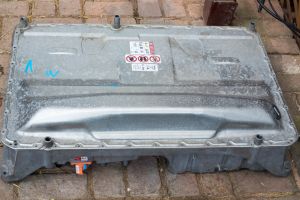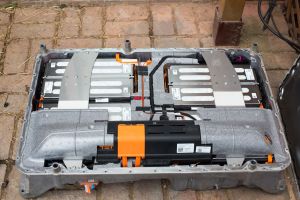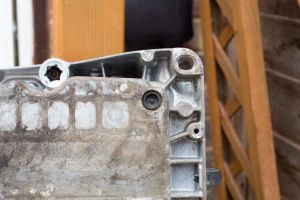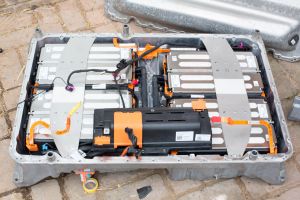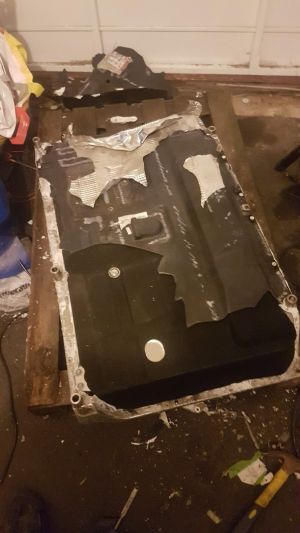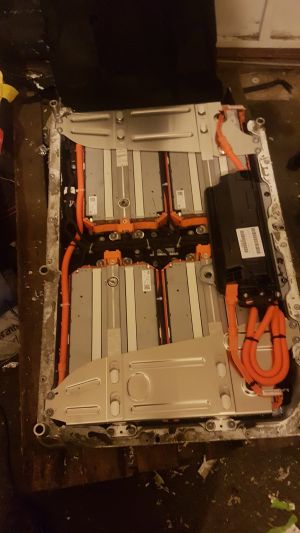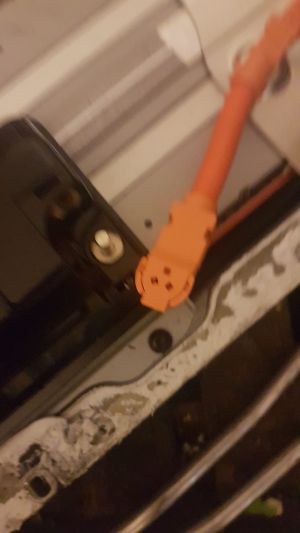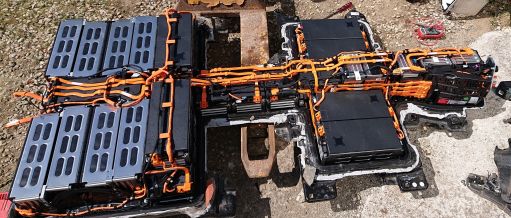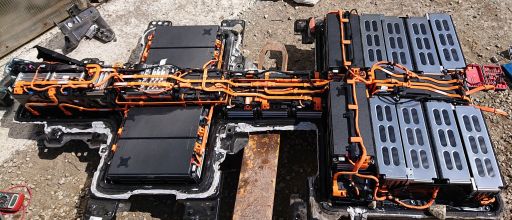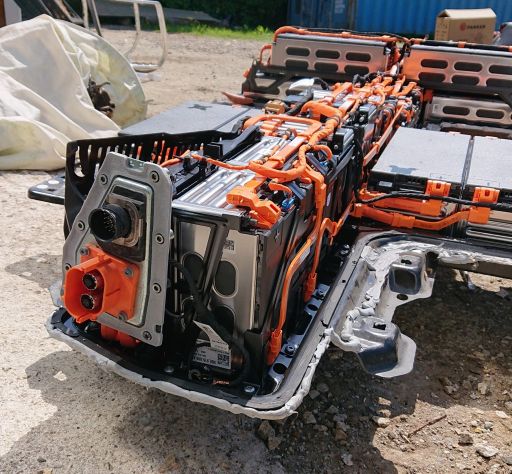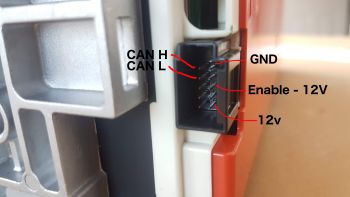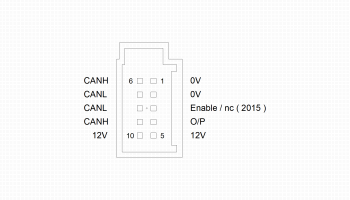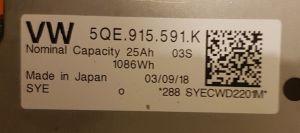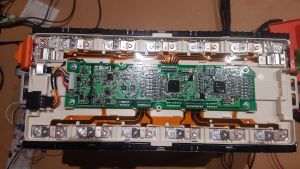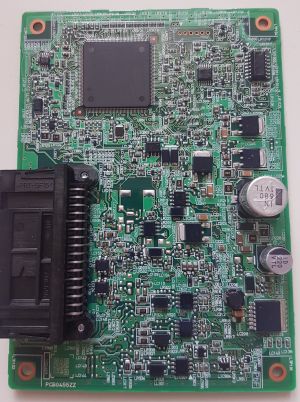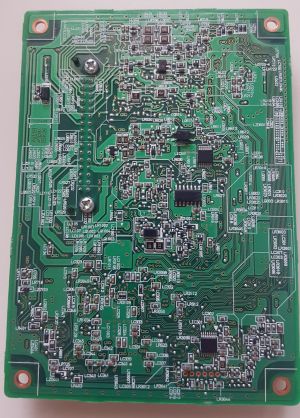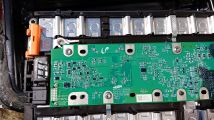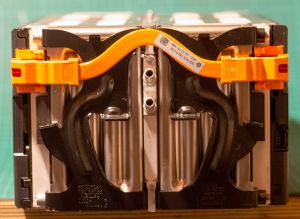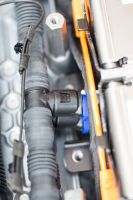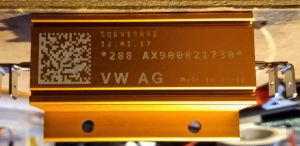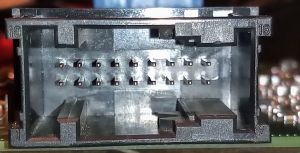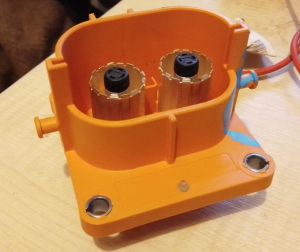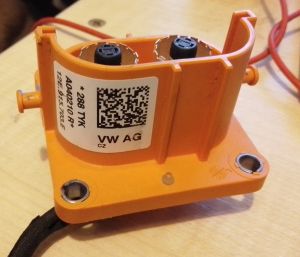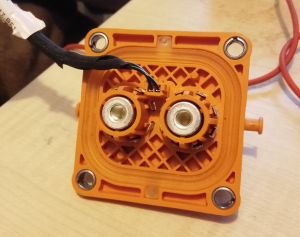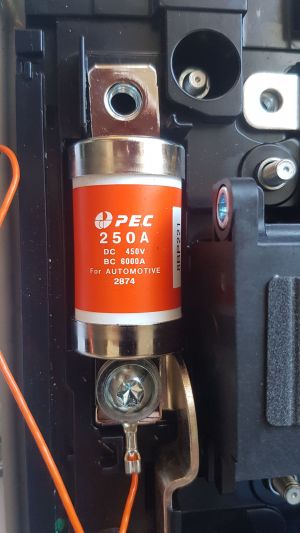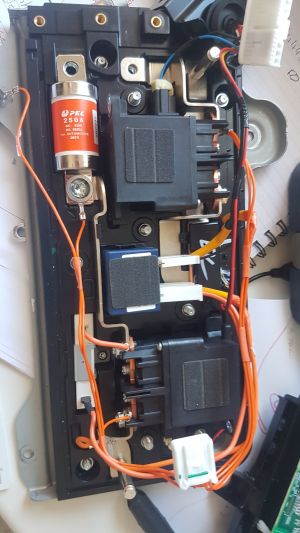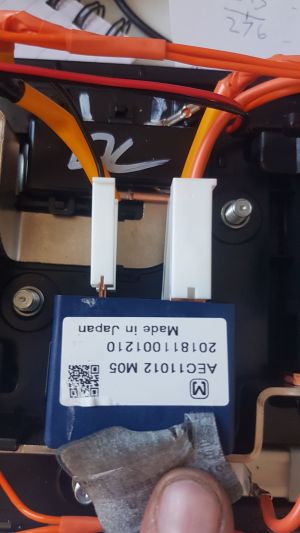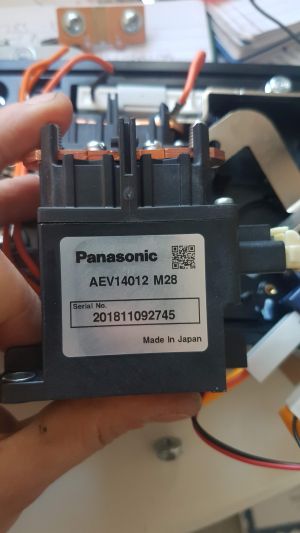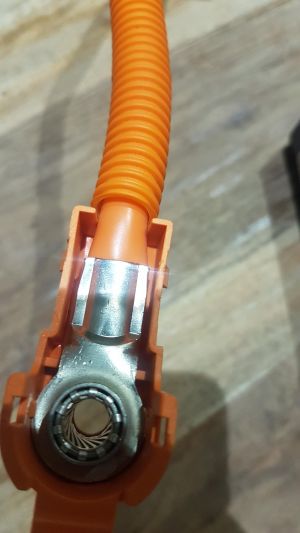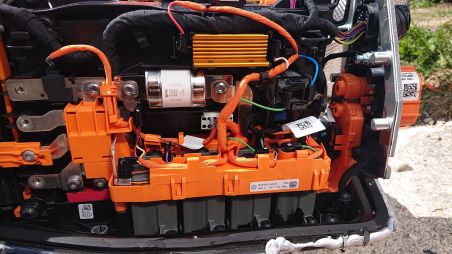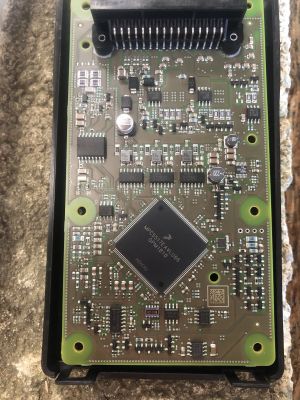VW Hybrid Battery Packs: Difference between revisions
m (→BMS: Adding part number for connector) |
(→BMS) |
||
| Line 276: | Line 276: | ||
Connector is: TE Connectivity 1-1670990-1 | |||
Connector is: TE Connectivity 1-1670990-1, search ali-express for 6R0 972 930 looks to be the same | |||
Terminals are: | Terminals are: | ||
Revision as of 07:53, 3 February 2023
Information on reusing VW Golf/Passat GTE hybrid battery Packs.
Specification Overview
Passat GTE
The 9.9 KWH Passat GTE battery pack contains 96S 28AH Samsung cells arranged in to 4 modules of 24S with a liquid cooled heatsink down the middle.
Note: Battery capacity has been increased to 13kwhr in circa 2019 (assumed to be 37ah cells).
Golf GTE
The Golf GTE battery pack has a plastic top cover, containing 8.7 KWH Panasonic cells arranged in to 4 modules of 24S with a liquid cooled heatsink down the middle.
The external signals are via a 14 pin connector (Sumitomo 6189-7103)
| Pin | Colour | Notes | |
|---|---|---|---|
| 1 | Orange & Black | CAN H - Power Train | |
| 2 | Orange & Brown | CAN L - Power Train | |
| 3 | Blue | Airbag Control Module | |
| 4 | Purple & Yellow | Pilot line (In) | |
| 5 | Purple & Yellow | Coolant Value | |
| 6 | Red & Grey | 12v 30 amp | |
| 7 | Green | Coolant Pump | |
| 8 | Black & Green | 12v (IGN) | Fuse 49 on fuse holder C |
| 9 | Brown | Earth | |
| 10 | Red & Grey | 12v 30amp Fuse | |
| 11 | Black & Green | Pilot Line (out) | connects to the HV connector interconnect, then BMS master, then Pilot In, there should be 150ohm resistor instead of the other components |
| 12 | Black | Airbag Control Module | |
| 13 | Orange & Grey | CAN H - Hybrid | |
| 14 | Orange & Brown | CAN L - Hybrid |
E-Golf
The 35.8kWh e-Golf pack is 88s3p, 111ah (37ah per cell) at 323v nominal with cells manufactured by Samsung SDI in contrast to the previous iteration of e-Golf that used Panasonic cells. The pack uses 17 blocks that look the same as GTE blocks however they are 4s3p vs 12s1p, in addition there are also 10 half sized blocks (2s3p) used in the make up to better fill up the transmission tunnel when the pack is bolted up to the under side of the vehicle. An extra complication over the GTEs is that rather than having a slave node in every block there are 8x 4s blocks containing slave boards while the other 19x blocks just contain cell taps and temperature sensors.
In Volkswagen terminology the cell tap blocks are called 'slave modules', the slave node blocks are called 'master modules' and the BMS master consists of unit J840 - Battery Regulation Control Unit and unit J497 Module Monitor Control Unit. Just to really confuse everyone...
Recomended reading - VAG SSP 586 - Volkswagens Self Study Program for the e-Crafter. The e-Crafter uses the 35.8kWh e-Golf battery pack while the actual SSP for the e-Golf (VAG SSP 530) still refers to 21.2kWh Panasonic pack.
| Pin | Colour | Connected to external to pack | Connected to internal to pack |
| T20q/1 | sw/bl | PIOLT LINE must form a circuit with T20q/14 (J840 T32j/5) | HV connector contacts – J840 T32j/21 |
| T20q/2 | gn | Maintenance plug for high voltage system, 12v+ when connected | Junction – J840 T32j/32 + J497 T18c/1,T18c/2 |
| T20q/3 | ge | 15a Ignition Live Power | Junction – J840 T32j/14 + J497 T18c/6 |
| T20q/4 | ge/rt | Drivetrain CAN-bus High (diagnostic connection) | J840 T32j/3 |
| T20q/5 | ge/br | Drivetrain CAN-bus Low (diagnostic connection) | J840 T32j/4 |
| T20q/6 | bl/rt | Airbag control unit – SIG+ | J840 T32j/13 |
| T20q/7 | bl/ge | Airbag control unit – SIG- | J840 T32j/29 |
| T20q/8 | |||
| T20q/9 | br | Earth | Junction - J840 T32j/16,/30 + J497 T18c/8,/9,/18 + J1068 T10/1 |
| T20q/10 | or/sw | Hybrid CAN-bus High | J840 T32j/18 |
| T20q/11 | or/br | Hybrid CAN-bus Low | J840 T32j/19 |
| T20q/12 | rt | 30a Permanent Live | Junction - J840 T32j/17 + J497 T18c/10 |
| T20q/13 | |||
| T20q/14 | sw/gn | PIOLT LINE must form a circuit with T20q/1 (J840 T32j/21) | J840 T32j/5 |
| T20q/15 | |||
| T20q/16 | |||
| T20q/17 | |||
| T20q/18 | |||
| T20q/19 | |||
| T20q/20 |
Disassembly
I Can Not understate the importance of Insulation when dealing With High Voltages, Both of your tools and yourself of course! Also ensuring that we do everything to prevent a Short Circuit.
All Metal tools were covered in Tape And/Or Heat Shrink so that in the event of a drop there would not be a dangerous short circuit, and also as an added layer of insulation from the battery to myself!
I only ever toughed the HV contacts when I absolutely had to, no point taking chances!
Useful/Tools used:
- Torx & Socket Drive Set (insulated with shrink wrap/tape)
- Electric Screwdriver
- Magnet on a stick (Covered in tape of course)
- Insulation Tape & Duct Tape
- Gloves … I used nitrile gloves, Electrician’s gloves & some garden gloves so I didn’t tear the electrical gloves.
- Electrical screwdrivers & a normal screwdrivers covered in insulation tape.
- Voltmeter
- Insulated shoes
- Nylon straps the battery came tied to the pallet.
- Emergency help on hand in case of electrocution (including gloves for them & I attached one of the nylon straps to myself so I could be pulled away)
- Work in the dry obviously
After Undoing all of the torx bolt on the top the cover can be removed … look at those precision straps to hold the modules down.
At this point after prodding about underneath the foam and looking down the sides I need access to the bottom to unbolt the modules, find that un-loved screwdriver (covered in paint in my case on top of my daughter’s rabbit hutch) and use gentle persuasion to remove the rubber plugs to get access to the torx bolts and remove them. Be very careful this thing is damn heavy you don’t wan this to land on your toes or any part of your body
Now back to the top side … remove all the foam, disconnect all of the cables you can (I could not remove the module bms plugs). Happily my module sat at 355 volts (88.8v per module) so not too low at about 3.7v per cell!
I then started tackling all of the bolts holding down the modules in the middle, however then came the ones that were under the Contactor box.
The scary bit where I disconnected the HV connections from the Contactor box thing, immediately covering with insulation tape, first negative, positive, then I tackled the mid pack connection (not shown in this photo). Then I removed all of the connections from the contactor box to allow it the removed to allow access to the torx bolts obstructed by it.
Now back to the top side … remove all the foam, disconnect all of the cables you can (I could not remove the module bms plugs). Happily my module sat at 355 volts (88.8v per module) so not too low at about 3.7v per cell!
I then started tackling all of the bolts holding down the modules in the middle, however then came the ones that were under the Contactor box.
The scary bit where I disconnected the HV connections from the Contactor box thing, immediately covering with insulation tape, first negative, positive, then I tackled the mid pack connection (not shown in this photo). Then I removed all of the connections from the contactor box to allow it the removed to allow access to the torx bolts obstructed by it.
Golf GTE
The same safety advice as above applies, these packs are over 350V DC, this can be LEATHAL. DO NOT BE COMPLACENT.
The Golf GTE pack is a heafty aluminium box with a plastic lid. The lid is covered in a very thin aluminium layer. I found it quite a task to break in, there's a lot of silicone around the perimeter. I used a mixture of breaking the cover and levering it up as much as possible and cutting the silicone.
Under the plastic is a blanket covering the modules. The goodies are underneath.
The next task I did was to remove the main leads from the battery pack to the contactor box. These just lift up to disconnect, they are pretty well insulated but take no chances, they are direct to the modules, always live. With both of these removed you can begin un bolting the contactor box.
E-Golf
The same safety advice as above applies, these packs are over 350V DC, this can be LEATHAL. DO NOT BE COMPLACENT. In addition the e-Golf has a capacitor across positive and negative inside the contactor box ENSURE THIS IS DRAINED using an appropriate resistor.
The e-Golf has a steel base plate that the modules are bolted to and a fiber glass top cover that is held down with a handful of fixings and a lot of very tough mastic. Using a craft knife with a retractable blade you can set the depth to avoid cutting into anything beyond the mastic.
The bolts surrounding the HV and LV connector plate at the front have to be removed and also the HV connector plate at the rear that connects to the DC rapid charge before the top cover can be removed.
As there is no HV service disconnect and all of the battery connections are well torqued TX bolts, breaking the pack down to a safe working voltage is a serious undertaking. Once again there is a capacitor across main battery positive and negative THIS MUST BE DISHCHARGED SAFELY, IT ALONE IS LEATHAL.
BMS
The BMS slaves on the modules can be re-used using SimpBMS running on a Teensy Microcontroller.
https://github.com/Tom-evnut/SimpBMS
https://github.com/Tom-evnut/VW-bms
Each half-module will need connecting to the can bus for SimpBMS, top right as you are looking at it is pin 1 - GND, move down and skip one pin to 3 - Enable (12V), move down again and skip one to pin 5 - 12v. Top left is pin 6 CAN HIGH, and the one under it is pin 7 CAN LOW.
Connector is: TE Connectivity 1-1670990-1, search ali-express for 6R0 972 930 looks to be the same
Terminals are:
The BMS has to send a CAN Frame with 0x0BA to request the module data.
| ID | Data |
|---|---|
| 0x0BA | 0x00 0x00 0x00 0x00 0x00 0x00 0x00 0x00 |
| 0x0BA | 0x45 0x01 0x28 0x00 0x00 0x00 0x00 0x30 |
With a little experimentation the 0x00 0x00 0x00 0x00 0x00 0x00 0x00 0x00 is not required to get the cell voltages, a message with just 0x00 0x00 0x00 0x00 0x00 0x00 0x00 0x10 seems to be sufficient. So it seems bit 4 of the 8th byte is a flag to send voltages.
The Modules will respond by sending out frames with the IDS 0x1CC to 0x1D4
There's a DBC file https://github.com/jamiejones85/DBC-files/blob/master/VW-GTE-HV-Battery.dbc for use with SavvyCan
Battery Modules
Passat GTE
The Battery Module weighs 23.4 Kg, (Add module dimensions), There is a BMS connector (TE 1-1670990-1) on both sides of the the module.
Golf GTE
Each module consists of 2 rows of 12 cells, with a liquid cooling plate between then. Each block of 12 cells is 1086Wh, so each module is 2172Wh.
Roughly 240mm wide, 440mm in length and 150mm in height, each module weights []. One side has a mounting bracket close to the base, the other has one towards the top.
E-Golf
The e-Golf slave board has the same 10 pin connector, seen on the right, as the GTE but there is a further 10 pin connector (cell taps from the cell tap blocks) and an 8 pin connector (temperature sensors from the cell tap blocks) on the left.
Cooling
The Battery Cells are cooled by a liquid cold plate in the middle of the module, the outside diameter of the metal pipe connector is 8.0mm
Contactors/Pre-Charge
Passat GTE
The Control box contains
- PEC 300A 450VDC fuse
- 2 x Contactors (Data Matrix Code '#3Q0915646B ###100117*288 LS301CRFIFO*=', Non Economiser Type Current Draw 0.556A@12.8V)
- 1 x Pre-Charge Relay (Data Matrix Code '#3Q0915646A ###281116*288 LS301HGC9KB*=')
- 1 x Pre-Charge Resistor (Resistance TBC)
- 1 x Current Shunt (Data Matrix Code:p88970180259, Rating TBC)
- 1 x Contactor Control Board
Reusing with Open Inverter controlling the contactors and relay directly should be as simple as supplying 12v and switching the ground as required.
The control board has the following connector(s)
| Control board Interface Connector | |
The pinout is as follows:
| Pin | Function | Wire Colour | Notes |
|---|---|---|---|
| 1 | +12v | Green | Live when service plug installed |
| 2 | +12v | Green | Live when service plug installed |
| 3 | |||
| 4 | COMs | Black/Grey | COM line to J840 (maybe LIN?) |
| 5 | |||
| 6 | GND | Brown | GND to battery casing |
| 7 | |||
| 8 | GND | Brown/Red | Vehicle GND |
| 9 | GND | Brown/Red | Vehicle GND |
| 10 | +12V | Red | KL30 (permenant live) |
| 11 | |||
| 12 | |||
| 13 | |||
| 14 | CANH | Orange/Blue | 120 OHM, internal to pack only |
| 15 | CANL | Orange/Brown | 120 OHM, internal to pack only |
| 16 | +12V | Yellow | KL15 (ignition live) |
| 17 | |||
| 18 | GND | Brown/Red | Vehicle GND |
Pins 1, 2 (green), 16 (yellow) & 10 (red) are required for can bus to output
Can output ...
| CAN ID | Function | Notes |
| 000000BB | Shunt, Bytes 1 & 2 (16bit signed integer) | Multiply by 0.00625 to get amps |
| 18FED007 | ||
| 0000015B | ||
| 18FED008 | ||
| 18FED009 | Bytes 0 & 1 (16bit integer) | Possible Candidate Voltage @ Fuse |
| 18FED00A | ||
| 18FED003 | ||
| 18FED004 | ||
| 1A55545F | ||
| 16A95419 | ||
| 18FED006 | ||
| 18FED002 | ||
| 18FED005 |
Early DBC file only reads Shunt Current https://drive.google.com/file/d/1iG0pXk8BdoYc2XFG5V1_bZaf9pgPySye/view?usp=sharing
sample Saavycan capture with 5amps load https://drive.google.com/file/d/1zqkIfVTC2r4Nmz_XZJmQcCdNYnU14yxu/view?usp=sharing
BMS Control Module
(This is not needed when used with SIMPBMS, but may provide a source of can information for controlling the contactor board)
CAN ID'S outputted on Control Board CAN Line
| CAN ID | Function | Notes |
| 000000BA | Module Wake up | |
| 1BFFDA1A | ||
| 1BFFDA19 | ||
| 1A55540A | ||
| 1A55540B | ||
| 1A55540C | ||
| 1A55540D | ||
| 1A555410 | ||
| 1A555411 | ||
| 1A555412 | ||
| 1A555413 | ||
| 1A555414 | ||
| 1A555415 | ||
| 1A555416 | ||
| 1A555417 | ||
| 1A555418 | ||
| 1A555419 | ||
| 1A55541E | ||
| 1A55541F |
sample Saavycan capture from BMS Master (with nothing else connected):
https://drive.google.com/file/d/1EChKUwvZnYf_ncV8dCkwt0RWIQ2EQWO8/view?usp=sharing
High Voltage Connector
The External High Voltage connector is believed to be at TE 2141227-2 (https://www.te.com/global-en/product-2141227-2.html)
A compatible version has been found https://www.aliexpress.com/item/1005003639011124.html?spm=a2g0o.order_list.0.0.56cb1802CCwIg8 (Type ST516000)
Golf GTE
The control box contains a
- PEC 250A 450VDC fuse
- 2 x Panasonic AEV14012 M28 contactors https://docs.rs-online.com/6251/0900766b80e1fbed.pdf, yazaki 7283-1020 is the connector (would recommend a better contactor, I've welded one of these closed pretty easily)
- pre-charge relay and resistor,
- Current shunt.
| PN: N 02 080 6121 002 (unconfirmed) |
|---|
Reusing with Open Inverter controlling the contactors and relay directly should be as simple as supplying 12v and switching the ground as required.
The main control board has 2 connectors, one end looks to be high voltage and the other has the external connections and precharge/contactor controls.
| Pin | Function | Wire Colour | Additional |
|---|---|---|---|
| 1 | Connects to battery case | Black | Ring terminal on the end, maybe for isolation test? Seems to output 5v. |
| 2 | Gnd | Black | |
| 3 | N/C | ||
| 4 | CAN H | White | 125ohm resistance between them. IC501 - TJA1042 |
| 5 | CAN L | Black | |
| 6-9 | N/C | ||
| 10 | 12v | Red | 12V input. |
| 11 | 12v | Red | 12V input. When supplied, IC204 begins outputting 5V |
| 12 | 12v ignition | White | Looks to be ignition 12v |
| 13 | N/C | ||
| 14 | 12v | White | Enables the 12v to the contactors. |
| 15-19 | N/C | ||
| 20 | Pre charge relay switched gnd | Black | Q409 is responsible for switching this to ground. |
| 21 | Contactor switched gnd | Black | Q408 is responsible for switching this to ground. |
| 22 | Contactor switched gnd | Black | Q408 is responsible for switching this to ground. |
| 23 | 12v for precharge relay | Yellow | Isolated from 12v supply, IC401 |
| 24 | 12v for contactor | Blue | Isolated from 12v supply, IC401 |
| 25 | 12v for contactor | Red | Isolated from 12v supply, IC401 |
| 26 | N/C |
High voltage side has a LTC1391 (https://www.analog.com/en/products/ltc1391.html) 12bit ADC, at a guess relating to voltage and current measurements.
2 x UM5401 Quad-Channel Isolators with Integrated DC-to-DC Converter
2 x V216HC4 unknown
E-Golf
All the components here appear to be the same as the passat GTE, notable exceptions:
1x PEC 400A fuse
4x 3Q0915646B contactors (2x for CCS)
1x Pre-Charge Relay 3Q0915646A
1x Pre-Charge Resistor
1x Voltage based Shunt
1x Capacitor
1x BMS Master Module, J840
1x Contactor Control Board, J497
J497 Module Monitor Control Unit
| Pin out for J497 | ||||
| Low voltage external connector | T18c/1 | gn | Service Plug | KL30a when service plug inserted |
| T18c/2 | gn | Service Plug | KL30a when service plug inserted | |
| T18c/3 | ||||
| T18c/4 | sw | J840 Link | direct line to J840 | |
| T18c/5 | ||||
| T18c/6 | br | GND | Ground of battery casing | |
| T18c/7 | ||||
| T18c/8 | br | GND | Vehicle Earth | |
| T18c/9 | br | GND | Vehicle Earth | |
| T18c/10 | rt | KL30a | ||
| T18c/11 | ||||
| T18c/12 | ||||
| T18c/13 | or/br | Hybrid CAN-l | CAN bus for cell modules | |
| T18c/14 | or/bl | Hybrid CAN-h | CAN bus for cell modules | |
| T18c/15 | ||||
| T18c/16 | ge | KL15a | Ignition live | |
| T18c/17 | ||||
| T18c/18 | br | GND | Vehicle Earth | |
| High voltage tap/sense lines | T12i/1a | ws/ge | HV- tap | HV- tap output side drive contactor |
| T12i/2a | vi | HV- tap | HV- tap battery negative | |
| T12i/3a | ws | HV+ tap | HV+ tap input side precharge relay | |
| T12i/4a | rt/bl | HV+ tap | HV+ tap battery positive post fuse | |
| T12i/5a | gr | SIG | HV+ shunt high | |
| T12i/6a | ||||
| T12i/1b | gn | HV+ tap | HV+ tap output side drive contactor | |
| T12i/2b | ws/sw | HV- tap | HV- tap external side aux contactor | |
| T12i/3b | rt/sw | HV+ tap | HV+ tap battery positive | |
| T12i/4b | ws/bl | HV+ tap | HV+ tap external side aux contactor | |
| T12i/5b | gr/sw | SIG | HV+ shunt low | |
| T12i/6b | ||||
| Low voltage contactor drive | T12j/1 | br | GND | Coil – for Precharge Relay |
| T12j/2 | br | GND | Coil – for HV+ Drive contactor | |
| T12j/3 | br | GND | Coil – for HV- Drive contactor | |
| T12j/4 | br | GND | Coil – for HV+ Aux contactor | |
| T12j/5 | br | GND | Coil – for HV- Aux contactor | |
| T12j/6 | ||||
| T12j/7 | sw | CTRL | Coil + for Precharge Relay | |
| T12j/8 | ge | CTRL | Coil + for HV+ Drive contactor | |
| T12j/9 | rt/ge | CTRL | Coil + for HV- Drive contactor | |
| T12j/10 | gn | CTRL | Coil + for HV+ Aux contactor | |
| T12j/11 | ||||
| T12j/12 | gr | CTRL | Coil + for HV- Aux contactor | |
| Battery Tap | T4bx/1 | |||
| T4bx/2 | ||||
| T4bx/3 | bl | Centre Tap | Centre cell tap from HV battery | |
| T4bx/4 | ||||
J840 Battery Regulation Control Unit
| J840 pin out | |||
| T32j/1 | or/bl | Hybrid CAN-h | To cell modules and J497 |
| T32j/2 | or/br | Hybrid CAN-l | To cell modules and J497 |
| T32j/3 | ge/rt | Power CAN-h | To powertrain CAN bus |
| T32j/4 | ge/br | Power CAN-l | To powertrain CAN bus |
| T32j/5 | sw/gn | PIOLT | HV connection PIOLT line (must form circuit with T32j/21) |
| T32j/6 | |||
| T32j/7 | |||
| T32j/8 | |||
| T32j/9 | |||
| T32j/10 | gr | Module KL30a | 12v+ power to cell modules |
| T32j/11 | |||
| T32j/12 | gn/rt | Enable | Cell module enable power to first module |
| T32j/13 | vi | SIG+ | Battery isolation igniter |
| T32j/14 | ge | KL15a | Ignition Live power |
| T32j/15 | br | GND | 31 Earth connection |
| T32j/16 | br | GND | 31 Earth connection (battery case) |
| T32j/17 | rt | KL30a | Permenant live |
| T32j/18 | or/sw | Hybrid CAN-h | To hybrid CAN bus |
| T32j/19 | or/br | Hybrid CAN-l | To hybrid CAN bus |
| T32j/20 | sw | J497 link | Direct line to J497 |
| T32j/21 | sw/bl | PIOLT | HV connection PIOLT line (must form circuit with T32j/5) |
| T32j/22 | |||
| T32j/23 | |||
| T32j/24 | |||
| T32j/25 | |||
| T32j/26 | |||
| T32j/27 | |||
| T32j/28 | gn/bl | Enable Check | Enable signal return from last cell module |
| T32j/29 | vi/sw | SIG- | Battery isolation igniter |
| T32j/30 | br | GND | 31 Earth connection (battery case) |
| T32j/31 | |||
| T32j/32 | gn | Service Plug | KL30a power through HV service disconnect |
Using Multiple Packs
Note: This section is very very rough draft!!and needs a lot more work!
Currently NO Turn Key solutions exist for using more than 1 pack, however .... The items below have NEVER been tested and could only be described as experimental !!
- The next release of SIMP BMS (assuming to be V3) shall use a teensy 4 which will have 3 canbuses however this is in the early stages of development.
- It could be possible to use 2 sets of SIMPBMS however they would exist on 2 separate can buses, this would not to be easy task to implement.
- It could be possible to translate the CAN id's from the second pack by using a can in the middle and still use a single SIMPBMS however this has never been tested.
The can id's outputted from the modules are fixed, the ranges used are from 01B0 to 01CE (432-462).
If these CAN id's were translated (from the second pack) using a can in the middle device to id's to a range like 01D0 to 01EE (464-494) a single SIMPBMS could be used as there is an undocumented code allowing for extended id's within the VW SIMPBMS code.
Sample can id modifying code can be found in colin kidders git hub for the arduino due
https://github.com/collin80/due_can/tree/master/examples/CAN_TrafficModifier
Damian McGuire has created a can in the middle device
https://github.com/damienmaguire/CAN-BUS-Man-In-The-Middle
BMS code showing extended id's
https://github.com/Tom-evnut/VW-bms/blob/master/VWBMSV2/BMSModuleManager.cpp
Rough Draft of CAN ID translation concept, important note the reverse path needs adding.
There is a can id that simp bms sends out (00BA) that wakes up the modules, this needs to be passed through as is.
